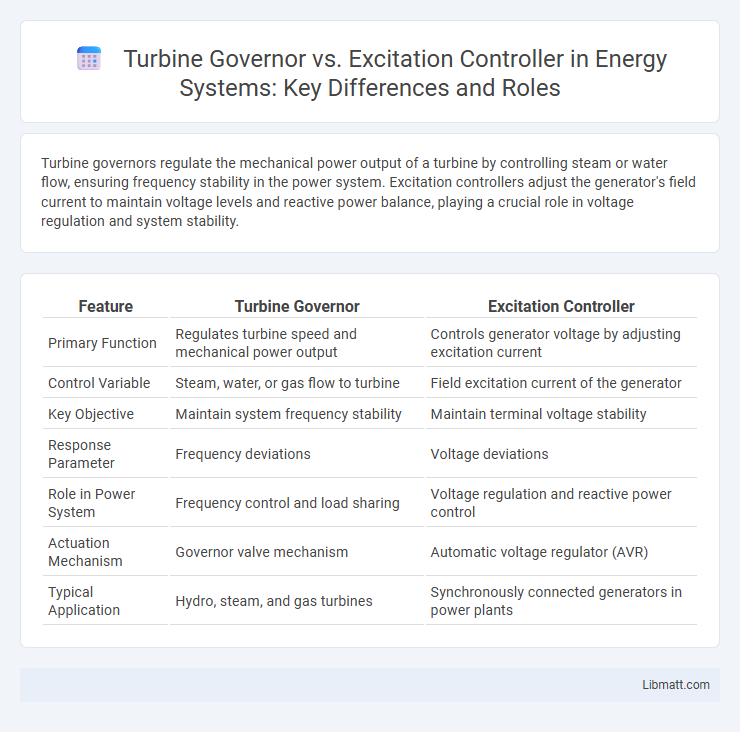Turbine governors regulate the mechanical power output of a turbine by controlling steam or water flow, ensuring frequency stability in the power system. Excitation controllers adjust the generator's field current to maintain voltage levels and reactive power balance, playing a crucial role in voltage regulation and system stability.
Table of Comparison
| Feature | Turbine Governor | Excitation Controller |
|---|---|---|
| Primary Function | Regulates turbine speed and mechanical power output | Controls generator voltage by adjusting excitation current |
| Control Variable | Steam, water, or gas flow to turbine | Field excitation current of the generator |
| Key Objective | Maintain system frequency stability | Maintain terminal voltage stability |
| Response Parameter | Frequency deviations | Voltage deviations |
| Role in Power System | Frequency control and load sharing | Voltage regulation and reactive power control |
| Actuation Mechanism | Governor valve mechanism | Automatic voltage regulator (AVR) |
| Typical Application | Hydro, steam, and gas turbines | Synchronously connected generators in power plants |
Introduction to Turbine Governors and Excitation Controllers
Turbine governors regulate the mechanical power output of turbines by adjusting the steam or water flow to maintain the desired generator speed and system frequency. Excitation controllers manage the voltage output of synchronous generators by controlling the field current, ensuring stable voltage levels and reactive power balance in power systems. Both components are crucial for maintaining grid stability and efficient power generation in modern electrical networks.
Fundamental Principles of Turbine Governors
Turbine governors regulate the rotational speed of turbines by adjusting steam or water flow to maintain system frequency and power balance, ensuring stable generator output. They utilize feedback control loops based on speed deviation to modulate the turbine input and prevent system oscillations or load fluctuations. Unlike excitation controllers, which manage voltage by regulating generator field current, turbine governors primarily focus on mechanical power control and frequency stability.
Key Functions of Excitation Controllers
Excitation controllers regulate the generator's field current to maintain voltage stability and improve reactive power control, ensuring efficient power system operation. They adjust the excitation voltage dynamically to respond to load changes, system faults, and voltage fluctuations, supporting power quality and grid reliability. Unlike turbine governors that control mechanical input and rotational speed, excitation controllers directly manage the generator's electromagnetic output characteristics.
Comparison: Roles in Power System Stability
Turbine governors regulate the mechanical power input to the generator, maintaining the system frequency by adjusting turbine output in response to load changes, which is crucial for primary frequency control. Excitation controllers manage the generator's voltage by controlling the field current, ensuring voltage stability and reactive power balance within the power system. Understanding these complementary roles helps your power system remain stable by coordinating frequency and voltage control mechanisms effectively.
Response Time: Turbine Governor vs Excitation Controller
Turbine governors typically have slower response times compared to excitation controllers, with governors adjusting steam flow over several seconds to minutes to regulate generator speed and system frequency. Excitation controllers respond within milliseconds to seconds, rapidly modulating the generator's field current to stabilize voltage and improve transient stability. Your power system's dynamic performance heavily depends on the fast-acting excitation controller for voltage regulation, while the turbine governor manages mechanical power input more gradually.
Impact on Frequency Regulation and Voltage Control
Turbine governors primarily regulate system frequency by adjusting the mechanical input to the generator, ensuring balance between power supply and demand. Excitation controllers manage voltage control through precise adjustment of the generator's excitation current, stabilizing voltage levels within the grid. Understanding the distinct roles of turbine governors and excitation controllers helps optimize your power system's frequency stability and voltage regulation.
Integration with Modern Power Systems
Turbine governors and excitation controllers play crucial roles in maintaining stability and efficiency in modern power systems by regulating mechanical input and generator voltage, respectively. Advanced turbine governors integrate with digital control systems to optimize frequency response and load sharing in real-time, enhancing grid reliability during fluctuations. Excitation controllers leverage adaptive algorithms to adjust reactive power output, supporting voltage stability and improving power quality amidst dynamic grid conditions and renewable energy integration.
Technologies and Control Strategies
Turbine governors utilize mechanical, hydraulic, or digital technologies to regulate turbine speed by adjusting steam or water flow, employing control strategies like proportional-integral-derivative (PID) loops and adaptive control for optimal power output and system stability. Excitation controllers manage the generator's field current using analog or digital excitation systems, applying voltage regulation techniques and advanced control algorithms such as automatic voltage regulators (AVR) to maintain steady terminal voltage and reactive power balance. Both systems integrate with supervisory control and data acquisition (SCADA) for real-time monitoring and adaptive response to grid disturbances, enhancing overall power system reliability.
Challenges and Limitations of Each System
Turbine governors face challenges in maintaining stable frequency control under rapid load changes due to mechanical delays and limited response speed, impacting overall grid stability. Excitation controllers struggle with precise voltage regulation because of nonlinear generator dynamics and external disturbances such as fault conditions, which can lead to instability or inefficient reactive power management. Both systems have inherent limitations in adaptability and synchronization within complex power networks, necessitating advanced control algorithms and coordination strategies for optimal performance.
Future Trends in Turbine and Excitation Control
Future trends in turbine governor and excitation controller technology emphasize enhanced integration with digital control systems and AI-driven predictive maintenance to improve efficiency and reliability. Advanced algorithms enable your power system to dynamically adjust to fluctuating grid conditions, ensuring stability and optimal performance. The shift towards renewable energy sources demands adaptive control strategies that enhance synchronization between mechanical turbine operations and electrical excitation processes.
Turbine governor vs Excitation controller Infographic

 libmatt.com
libmatt.com